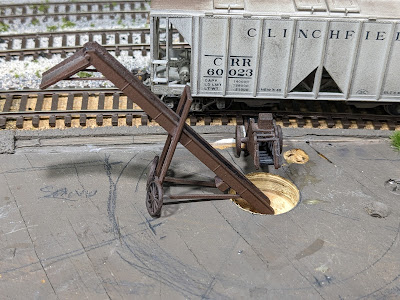I've finally gotten down to working on the scenery around the industries in Bryan Ferry. But since it takes me forever to actually finish anything, I thought I'd show you first the major sub-project in that endeavor by itself, which is the bulk storage bins for the Aidan foundry.
👉There's some interesting discussion around it, too - stay tuned!👈
The foundry receives coke, limestone, and pig iron in gondolas, and sand in covered hoppers. As a small-town furnace, their operations are a bit casual - bulk materials are unloaded with an ancient conveyor, and stored on the ground, and charged into the furnace used a bucket loader. Scrap is also a major inbound commodity, but being chunky and irregular, it can just be piled in a heap off to the side - no bin required.
So I've been staring at that odd-shaped blank space for years, knowing what I wanted to build - a set of bins radiating out from a movable conveyor - but stewing over how to terminate it at the layout edge. Any facility not extending beyond the layout would be ridiculously undersized, even by SNR standards - so an accommodation had to be made.
Now, I've sliced through foreground buildings before, and I've treated the raw slice in two different ways:

1). At the J.D. Bumhauer Co. in St. Amour, I left the building open at the section,
since the primary point was to provide a "railfan-through" scene,
where one can watch rail traffic roll by through the numerous
steel-sash windows, as I once did at a client in Hartford, Ct..
2). Whereas, for the sand bin on the Yaeger service tracks,
I built some mock-fascia to cover the exposure,
since in real life one wouldn't want to see the inside
of a giant pile of sand. Or so I thought at the time.
At the foundry though, I had these odd-shaped walls in irregular alignment, with some interesting material heaps in the foundryman's four favorite flavors. It seemed a shame to cover it all up with fascia - especially given that the wall slices go all the way to the top.
So I opted to reverse the sand bin ruling, and leave these bins exposed at the section - as if the material were piled up against a pet's terrarium glass, to be viewed from the outside - along with the pet - by a superior species. Well - at least a species that thinks it's superior to the pet.
The walls are foam-core, with the edges capped with putty. All five of them actually follow the same pattern, just being abbreviated in different places based on where they strike the layout edge.
As always with concrete, I painted them with a latex mix, using horizontal brushstrokes which help suggest the casual, small-batch pours that were used in the day. Initial weathering with washes of India ink highlighted the unevenness. The sectioned foam-core centers make pretty decent concrete cuts, I think - maybe I should add some rebar!
I did a quick mod on the Walthers conveyor to align the wheels circumferentially, allowing the conveyor to swing and serve any of the four commodities. Haven't thought through what the pit is going to look like yet - would they just leave a mix of spillage at the bottom, or clean it out after each unload?
I shaped the heaps first with foam and a hotwire, then covered them over. The limestone is ballast, but the sand and coke were done with bona-fide sand and coke. (For the record, all the coke and coal on the layout comes from nuggets of each I picked up as a kid, along the B&O in Tri-County. How's that for authentic.) Those three materials could be added after gluing the foam shapes into the bins.
For pig iron, though - in gondolas I use Chooch sugar-beet loads, which have textures that are surprisingly close in shape to the little piggies. When painted and weathered with oxides, they're pretty convincing. No such material exists in aggregate however. So I approximated it with aquarium gravel, except that had to be painted after heaping and gluing, but before installing. That was fun.
And there it is - inbound materials at long last. Next up, as Paul Harvey would say: "the rest of the story."
Eventually.
❓
👉 Faced with the same dilemma,
would you cover the section with fascia,
or show off the interesting stuff❓
👉 Is it silly to see the sheer faces of aggregate heaps❓
Thanks for reading, and let me know what you think!




















































